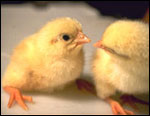
Chicks and balances.
Photo: USDA.
It’s very provoking, as Humpty Dumpty once told Alice, to be called an egg. After all, a name must mean something. “My name,” he told her, “means the shape I am — and a good handsome shape it is, too. With a name like yours, you might be any shape, almost.” The same could be said of many labels for poultry and eggs. After all, “cage-free” sounds pleasant — but does it guarantee that the chickens get outdoors? And what exactly is a “natural” hen? Sure enough, the more we look at certain labels, the less they seem to mean. Herewith, the inside scoop on chicken and eggs:
- “Free-Range”
“Free-range” or “free-roaming” on a label implies that the animal had unrestrained access to the outside world. In reality, though, the term only guarantees that the animal has had some opportunity to go outdoors each day — through a door left open at some point, for example — with no requirement that it actually gets there. Moreover, the use of the term “free-range” is only defined for chickens that are eaten, not those that lay eggs. The U.S. Food and Drug Administration, which regulates the egg market, has set no standard for the use of the term “free-range” for eggs, rendering the word essentially meaningless: The label does not guarantee that egg-laying birds live cage-free. There is also no third-party verification for this label, and hence no consistent meaning. - “Cage-Free”
This term guarantees that the chicken were not housed in cages — however, it does not guarantee access to the outdoors, and it is not verified by any third party. - “Natural”
While “natural” meat must be minimally processed and free of any artificial flavors, colors, or preservatives, this is “perhaps the most misleading” label claim, says Jessica Nelson of the Institute for Agriculture and Trade Policy. Why? Because the U.S. Department of Agriculture allows this label to be applied to meat from animals raised using hormones or antibiotics as growth promoters. In addition, there is no third-party verification for this label. - “Raised without antibiotics” or “No antibiotics administered”
These labels may be used by producers with USDA approval, but this claim is not verified by inspections of farms or by tests for residues in meats. The USDA has defined both of these labels to mean the animals were raised without the use of low-level or therapeutic doses of antibiotics. Nonetheless, the USDA considers use of the term “antibiotic-free” impossible to prove for chicken or other poultry products. These terms are not defined for eggs. - “Grass-Fed” or “Pastured”
This label indicates that the animals have, in some sense, been raised on pasture. However, because there are no standards defining “grass-fed,” as there are for “organic” and “free farmed” (see below), and no third-party verification, this label leaves the consumer in the dark. Practitioners of grass-fed or pastured poultry often use rotational grazing systems with movable cages for at least some portion of the bird’s life. This is a desirable option (assuming it can be verified), as birds eat more naturally, consume fewer resources, and live more in tune with their natural behaviors and needs while on pasture. Many suppliers of grass-fed egg-producing hens also report that the eggs are higher than conventional eggs in healthy Omega-3 fatty acids. - “Organic”
In meat, poultry, and egg production, “organic” means:- The animals are provided with organic feed (food produced without insecticides, pesticides, genetic engineering, or sewage sludge, and not containing animal-derived proteins).
- Animals are raised “under conditions which provide for exercise [and] freedom of movement,” according to USDA organic regulations.
- The animals are raised without antibiotics or added growth hormones. Sick animals that require treatment with antibiotics must be taken out of organic production.
- Meat is processed according to strictly defined standards that restrict the use of chemicals; the meat and eggs have not been irradiated.
- The animals are not genetically modified.
- The producers maintain safe composting standards for animal waste.
Meat, poultry, and dairy products that are at least 95 percent organic may be labeled “organic;” if entirely organic, they may be labeled “100 percent organic.” Products containing more than 70 percent organic ingredients may be labeled “made with organic ingredients.”

Great egg-spectations.
Photo: Washington State Dept. of Agriculture.
The benefits of buying organic meat and eggs are clear, given the host of harmful practices and substances that are kept out of the environment, the food system, and your body by organic practices. Supplying animals with organic feed supports a farm system that enhances soil fertility, increases species diversity, conserves water, and produces fewer greenhouse gases. The restriction on antibiotics also translates to healthier conditions for animals, because crowded, filthy quarters such as those found in factory farms require the use of antibiotics to prevent the spread of disease.
Note, however, that according to a January 2003 article in Consumer Reports, rates of salmonella and campylobacter in organic chicken can still be high. To avoid these diseases, organic meats must be handled just as carefully as their non-organic counterparts.
- “Free-Farmed”
“Free-farmed” poultry, eggs, and meat mean the animals are raised with adequate space and comfort, and without the use of unnecessary antibiotics, in accordance with American Humane Association standards. The claim is verified by third-party inspectors.
Color Me Organic
Easter is coming and you’ve got your free-farmed or organic eggs — so why not dye the shells naturally, too? There are a number of vegetable- and fruit-based dyes that offer a broad range of beautiful colors and are better for you and the environment than artificial colors. Below are some Easter egg tips taken from FoodTV, Recipe.net, The Joy of Cooking, and Organic Gardening.

Hardboil your eggs first, but not with a view to eat them if they will be un-refrigerated for more than two hours. Alternatively, you can puncture the ends of the raw eggs and blow out the contents, leaving them hollow. You can then boil your eggs in the dyes or dip them in cold. Boiling will give darker, more even colors; cool dipping may be better for children. To boil, add enough water to cover six to eight eggs, then add the dye ingredients and two tablespoon of white vinegar for each quart of water. Boil the eggs for approximately half an hour. For cold dipping, simmer the dye ingredients without eggs for 20 to 30 minutes, then strain and cool. Let the eggs sit in the dye for at least five minutes and up to several hours, turning occasionally, until they reach the desired color. When finished, you can rub the eggs with vegetable oil to give them a soft sheen.
The following dyes will give a range of intensities and surface textures to create a unique Easter egg basket. Measurements where given are approximate; play with additional spices, vegetables, and fruits for different results.
Green: Spinach (four cups per quart of water)
Pale yellow: Orange or lemon peels, carrot tops, celery seed, or ground cumin
Deep yellow: Ground turmeric in water with boiling eggs, or yellow onion skins.
Golden brown: Dill seeds or black walnut shells
Orange: Paprika (four tablespoons per quart water)
Dark orange: Chili powder
Tan: Coffee or tea
Blue: Red cabbage (four cups, shredded, per quart of water), or soak eggs in blueberry juice
Pink: Beet juice (4 cups, shredded, per quart of water), chopped rhubarb stalks, red onion skins
Lavender: Purple grape juice
Red: Pomegranate juice or four cups red onion skins


